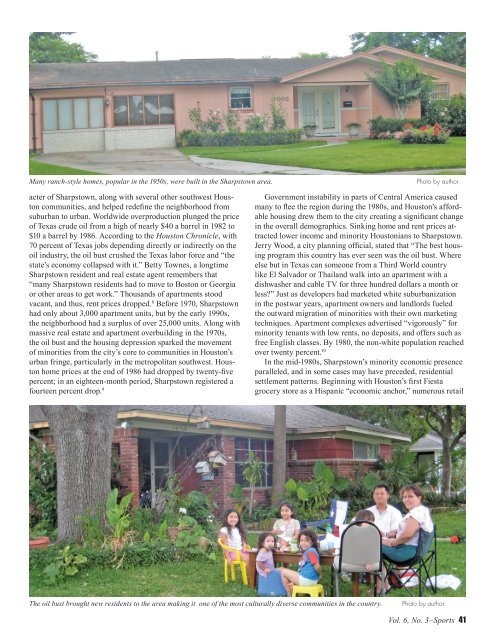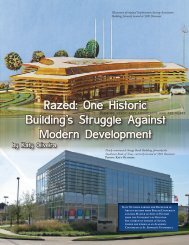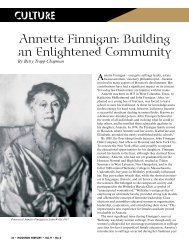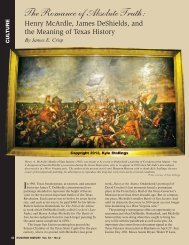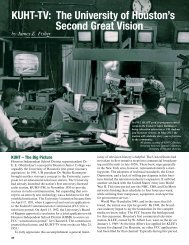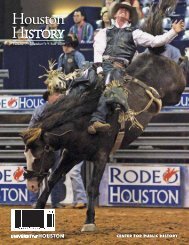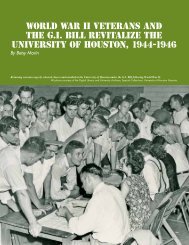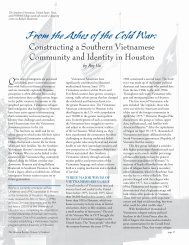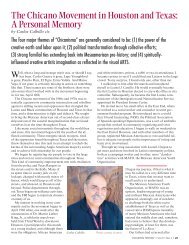Today, multilingual signage of businesses in the Sharpstown areareflects the neighborhood’s diversity.Photo by author.and increased gang activity by the 1980s and 1990s. Today,Bellaire Boulevard, formerly lined with predominately Angloownedstores and businesses, now boasts minority-ownedestablishments with multilingual signage, reflecting the area’sstatus as one of the most socially diverse communities in theUnited States.The history of Sharpstown calls into question some of ourmonolithic notions of “white flight” because as the community’sdemographics shifted, many longtime white residents didnot flee to racially-homogeneous suburbs. Longtime residentsresponded to the changes taking place around them in a varietyof ways, and homeowners devised several, often contentious,strategies of combating Sharpstown’s growing reputation asa suburb “fallen from grace.” Likewise, Sharpstown’s newresidents remade the landscape and contributed to its changingdefinition over time from suburban to urban.In 1954, developer Frank Sharp sold not only modern homes,but a planned lifestyle outside of the central city. “Too oftenwe find children living in congested areas which have grownup without planning,” Sharp claimed. “Life in Sharpstown issecure, satisfying, happy and friendly-because it was plannedthat way,” he continued. By painting a picture of the suburbas safe and appealing, he implicitly labeled the city as dangerousand unattractive. In the mid-fifties, Sharpstown embodiedwhat Americans have come to know as suburban culture. Thecommissioner of the Federal Housing Administration (FHA)predicted in 1955 that it would become a model for Americanresidential housing. Sharp marketed the FHA-funded enterpriseas “a new experiment in our way of life.” 5The opening in 1961 of <strong>Houston</strong>’s first enclosed, air-40 Vol. 6, No. 3–Sportsconditioned shopping center changed the neighborhood froma residential enclave to a regional hub of strip commercial developments,fast-food chains, and high-rise office complexes. The$30 million shopping complex heralded in an extensive array ofmixed-use areas, often centered on retail markets and commercialactivity.Between 1960 and 1970, land-use practices broke the continuityof the “planned” community. With <strong>Houston</strong>’s non-existentzoning laws, large-scale apartment structures sprang up all overthe neighborhood, attracting younger, single newcomers to thearea. 6 Although Sharpstown continued to remain predominantlywhite and middle-class, by 1960, a number of nonwhite familiessettled in Sharpstown. Largely affluent, these newcomers weremostly Cuban. A medical doctor and his wife for instance, emigratedfrom Cuba in 1960 and bought a house in Sharpstown,after renting an apartment close to downtown. The couple remembersthat neighbors welcomed them and their four children.They picked Sharpstown because they believed, at the time, thatit was the nicest community in <strong>Houston</strong>. Others often facingpolitical persecution, such as Luis Gonzalez, also fled Cuba inthe 1960s. He and his wife Georgina (also from Cuba), who hadlived and worked on Wall Street since the late 1940s, made theirhome in Sharpstown and began a family insurance business.Although the all-white community witnessed the beginnings ofsome diversity in the 1960s, social diversification on a massivescale would not appear for nearly twenty years. 7The Texas oil bust and subsequent collapse of the real estatemarket in the 1980s completely changed the demographic char-This ad appeared in the <strong>Houston</strong> Post on March 13, 1955,announcing the grand opening of the subdivision.
Many ranch-style homes, popular in the 1950s, were built in the Sharpstown area.Photo by author.acter of Sharpstown, along with several other southwest <strong>Houston</strong>communities, and helped redefine the neighborhood fromsuburban to urban. Worldwide overproduction plunged the priceof Texas crude oil from a high of nearly $40 a barrel in 1982 to$10 a barrel by 1986. According to the <strong>Houston</strong> Chronicle, with70 percent of Texas jobs depending directly or indirectly on theoil industry, the oil bust crushed the Texas labor force and “thestate’s economy collapsed with it.” Betty Townes, a longtimeSharpstown resident and real estate agent remembers that“many Sharpstown residents had to move to Boston or Georgiaor other areas to get work.” Thousands of apartments stoodvacant, and thus, rent prices dropped. 8 Before 1970, Sharpstownhad only about 3,000 apartment units, but by the early 1990s,the neighborhood had a surplus of over 25,000 units. Along withmassive real estate and apartment overbuilding in the 1970s,the oil bust and the housing depression sparked the movementof minorities from the city’s core to communities in <strong>Houston</strong>’surban fringe, particularly in the metropolitan southwest. <strong>Houston</strong>home prices at the end of 1986 had dropped by twenty-fivepercent; in an eighteen-month period, Sharpstown registered afourteen percent drop. 9Government instability in parts of Central America causedmany to flee the region during the 1980s, and <strong>Houston</strong>’s affordablehousing drew them to the city creating a significant changein the overall demographics. Sinking home and rent prices attractedlower income and minority <strong>Houston</strong>ians to Sharpstown.Jerry Wood, a city planning official, stated that “The best housingprogram this country has ever seen was the oil bust. Whereelse but in Texas can someone from a Third World countrylike El Salvador or Thailand walk into an apartment with adishwasher and cable TV for three hundred dollars a month orless?” Just as developers had marketed white suburbanizationin the postwar years, apartment owners and landlords fueledthe outward migration of minorities with their own marketingtechniques. Apartment complexes advertised “vigorously” forminority tenants with low rents, no deposits, and offers such asfree English classes. By 1980, the non-white population reachedover twenty percent. 10In the mid-1980s, Sharpstown’s minority economic presenceparalleled, and in some cases may have preceded, residentialsettlement patterns. Beginning with <strong>Houston</strong>’s first Fiestagrocery store as a Hispanic “economic anchor,” numerous retailThe oil bust brought new residents to the area making it one of the most culturally diverse communities in the country.Photo by author.Vol. 6, No. 3–Sports 41


